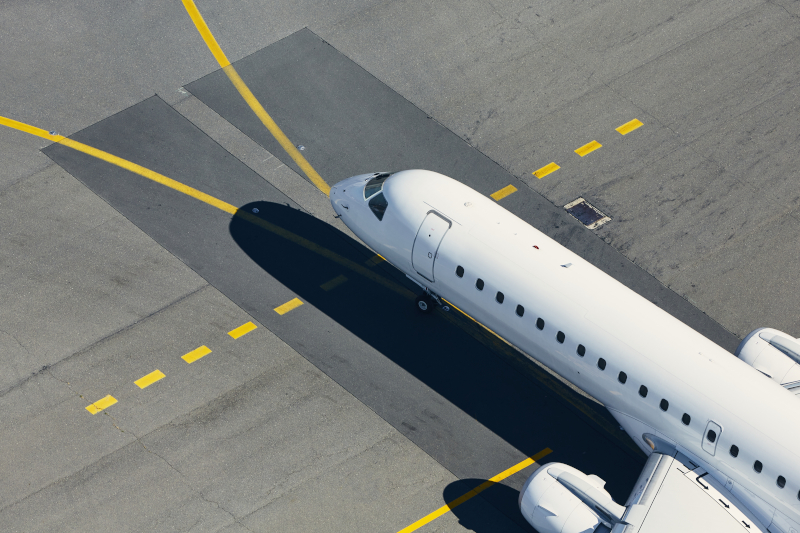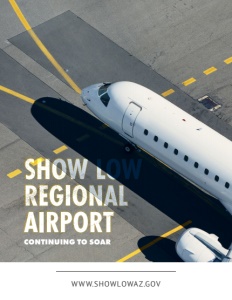Show Low Regional Airport
Show Low Regional Airport; Continuing to soar,
A Beacon of Progress in Arizona’s Skies
As the largest community in the White Mountains region, Show Low is also one of the fastest growing cities in northern Arizona. With a population of close to 12,000 residents, Show Low’s trade area reaches over 146,000 people, and is a hub of tourism and commerce amidst Arizona’s picturesque landscape.
Situated one mile east of the city, Show Low Regional Airport has evolved into a vital transportation resource for the area. Featuring two runways, a modern 6,400-square-foot terminal building, and convenient parking options, the airport has continued to progress since its establishment.
History and Growth
Show Low Regional Airport’s origins trace back to a US Forest Service special use permit, leading to its dedication in 1946. Initially, a dirt runway and a small terminal defined Show Low’s aviation landscape. Over the years, it has burgeoned into a Part-139 Commercial Service Airport, and in 1999 a modern terminal was added. Over the past decade, the airport has more than doubled its operations, as Jacob Allen, Show Low Airport Manager, conveys. “We have typically between 30 and 50 flight operations a day, which translates to approximately 20,000 operations per year.”
He shares that the airport has recently implemented an Advanced Dependent Surveillance-Broadcast (ADS-B) system, a sophisticated flight tracking technology. The system is able to provide a comprehensive report, revealing a total of 13,236 operations since April of 2023. Breaking down these operations by type, Allen notes that 47% are air taxi, 1% commercial, 52% general aviation, and 1% are military operations, emphasizing the diverse nature of activities at the airport.
 Facilities and Infrastructure
Facilities and Infrastructure
Covering 691 acres, the airport’s infrastructure includes two runways, the longer one spanning 7,200 feet and the other 3,938 feet. The city of Show Low owns and oversees the FBO, with Allen managing the linemen and fuel services associated with the operations at the airport. There are approximately 60 privately owned aircraft based at the facility, and private hangars are utilized for aircraft storage, while the city leases larger hangars to businesses on a multi-year basis.
The City of Show Low in coordination with Dibble Engineering, Armstrong Consultants, and the Federal Aviation Administration (FAA), have initiated a focused planning study aimed at reorienting the crosswind runway (Runway 4-22). The existing crosswind runway is not providing optimal wind coverage based upon the prior ten years of wind data collected at the airport. Additionally, in its existing orientation, Runway 4-22 will eventually need to be reconstructed and shortened significantly to meet current FAA runway design standards and safety area criteria, ultimately resulting in a less capable runway at SOW’s high field elevation of 6,413 feet above sea level.
The study will consider the purpose and need, include 25% engineering design, provide alternatives, and begin evaluating the environmental requirements associated with the development of a new runway. The FAA will use the analysis to determine if Airport Improvement Program (AIP) funding will be allocated for a new crosswind runway at Show Low Regional Airport. The focused planning study is scheduled to be completed late in 2024.
Big Dog Development LLC and the City of Show Low have recently partnered to transform vacant land on the airport into developable areas via an airport infrastructure project, which will include a new taxilane and the extension of vital utilities to support ten additional 65′ x 65’ hangar buildings. The City advertised the project publically for bids and Show Low Construction Inc. was selected as the contractor. A groundbreaking ceremony took place on December 4th 2023. Construction is currently underway and is scheduled for completion early next year.
An upcoming LED lighting project on the primary runway aims to enhance safety and efficiency. “That project was supported by the Arizona Department of Transportation. The contractor is just waiting on materials right now, but that project is scheduled to be completed before the end of the year,” says Allen, noting that the contracting company who will be completing that project is Pavex Corp. In other projects, he describes the recent rehabilitation of the south apron, by Show Low Construction, recounting, “There was an apron that existed there, but it was old and deteriorated. So, it was ripped out and completely reconstructed from the ground up. It wasn’t just a maintenance project.” Another valued partner is Armstrong Consultants, who serve as the consulting firm for the city, overseeing projects and contributing to the airport’s ongoing development.
Essential Air Service Program
The Essential Air Service Program, initiated in the late ’70s following airline deregulation, emerged as a response to the shift from airlines as public services supported by the federal government. With deregulation, there was no obligation for airlines to serve specific destinations, prompting the introduction of a subsidy to ensure air connectivity in rural areas. Allen, expands on the program, relaying, “The Department of Transportation is responsible for the Essential Air Service Program, and the intent is to connect rural communities that are of a certain distance from a hub airport, such as Sky Harbor, where you can fly to any destination, basically.”
Allen highlights the process, explaining that the Department of Transportation initiates the bid for airline service through a request for proposals. Qualified airlines interested in participating in the Essential Air Service program submit proposals, including pricing and proposed flight schedules. “Those contracts are typically for two years, and the city is given the opportunity to make a recommendation to the Department of Transportation about what airline we would like to serve us,” he explains. “For example, last time, we had three airlines submit a proposal, and then with the city a committee was put together to review them, weigh the pros and cons, and then make a recommendation to the DOT. But at the end of the day the Department of Transportation is paying for the subsidy 100%, and they get to make the final decision.
Show Low Regional Airport’s Economic Impact
The airport serves as an economic engine for Show Low and beyond, with a 2021 economic impact study revealing a staggering $9,342,000 for on-airport activities, $1,997,000 from visitor spending, and an indirect/induced economic impact of $8,470,000. Additionally, the airport sustains 118 jobs, generating $7,243,000 in earnings and contributing $18,809,000 to overall economic activity.
City of Show Low Economic Development Coordinator, Steve North, emphasizes Show Low’s role as the business and marketing center of northeastern Arizona. Positioned at the convergence of five state highways and in close proximity to interstate 40, Show Low’s strategic geographic location makes it a hub for business. “We’re seeing a shift, as a lot of other communities are, away from the coal influenced industry. And we’re seeing our light manufacturing, and aviation, really starting to take off. We’ve become a regional center of aviation really. We do also have developable properties on the airport grounds with runway access. So that’s a huge thing as well.”
For the city of Show Low, Tourism is a major economic driver, and the area is known for forestry and natural resources, which remains a vital industry. The region has diversified, with helium extraction and renewable energies emerging as key industries between Show Low and Holbrook. The area also sits on top of one of the largest aquifers in the western United States. North reports that Summit Healthcare Regional Medical Center is the largest employer in the area, acknowledging, “The hospital, along with all those ancillary medical related services, is a big industry as well. We get a lot of physicians going through the airport. And then we have operations occasionally where folks have to be transported from this hospital to other hospitals. So, the airport is a main asset that we are thankful to have.”
 Show Low Regional Airport’s Valuable Partnerships and Tenants
Show Low Regional Airport’s Valuable Partnerships and Tenants
North points out the significance of companies such as Aero Products in the community, stating, “Aero Products is a major employer in our area. Although their entire operation is not located at the airport, they do have a presence there and are a significant aviation-related company in our community.” Air ambulance companies such as Guardian Air, Sunrise Air Ambulance, and Native Air are crucial tenants of Show Low Regional Airport, contributing to the facility’s vibrancy. Regarding other valuable partnerships, Allen relays, “One of our tenants is the Bureau of Indian Affairs, which operates a single-engine air tanker operation from here. Several local businesses own hangar leases here at the airport, including Horne Automotive, a local business owner who keeps an aircraft here for business purposes.” Additionally, Navajo County collaborates with the airport and the city of Show Low, leasing modular buildings and conducting county business on the property.
A Vision for Growth
Considering the future, North remarks on the potential for growth for Show Low, particularly in outdoor-related products and firearms manufacturing, as well as the ongoing significance of medical services. “The assets continue to grow. We’re becoming very active in the nurturing and cultivating of entrepreneurs and business startups. We have a lot of folks that are operating up here, wanting to take advantage of the high quality of life, getting out of the metro areas and creating their own opportunities. We really think the airport is going to be a key part of that growth industry as well.”
Offering his thoughts on what comes next for Show Low Regional Airport, Allen concludes, “I think we can look forward to growth here at the airport and in the community. There are a lot of new subdivisions, a lot of people are moving into this community, and tourism continues to grow. The sky’s the limit for the airport here.”
AT A GLANCE
Show Low Regional Airport
What: A regional airport, located in one of the fastest growing cities in Northern Arizona
Where: Navajo County, Arizona
Website: www.showlowaz.gov




